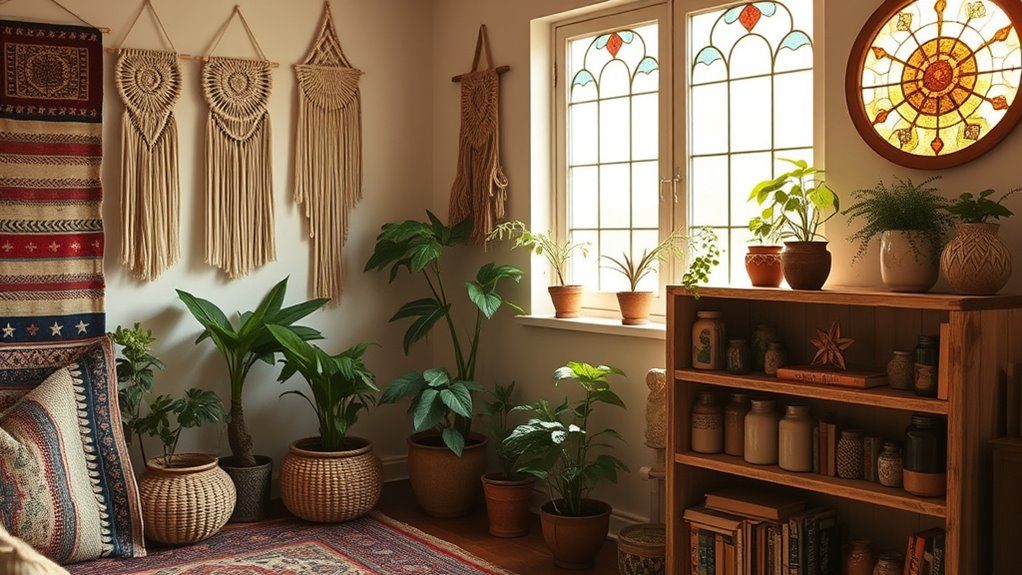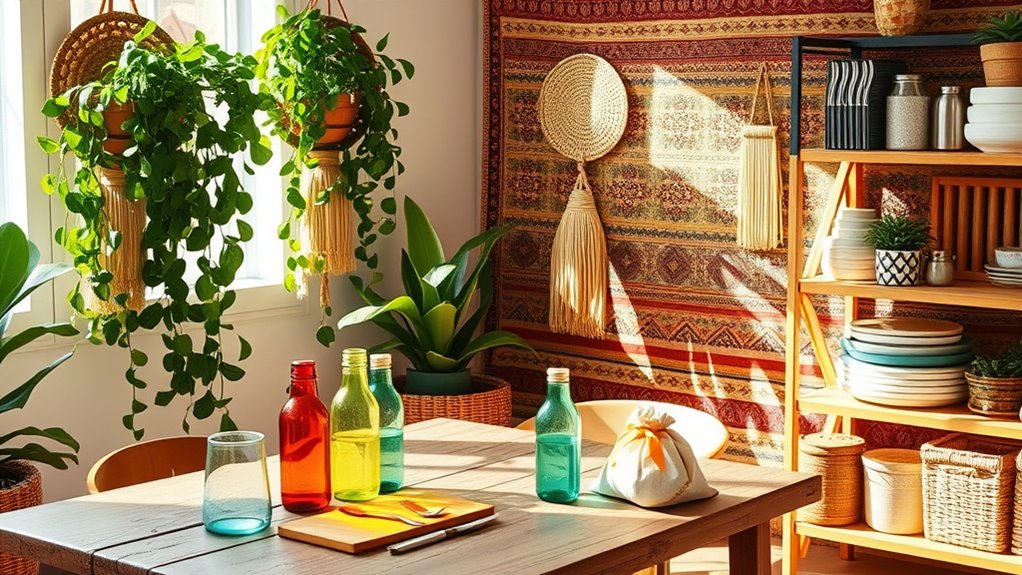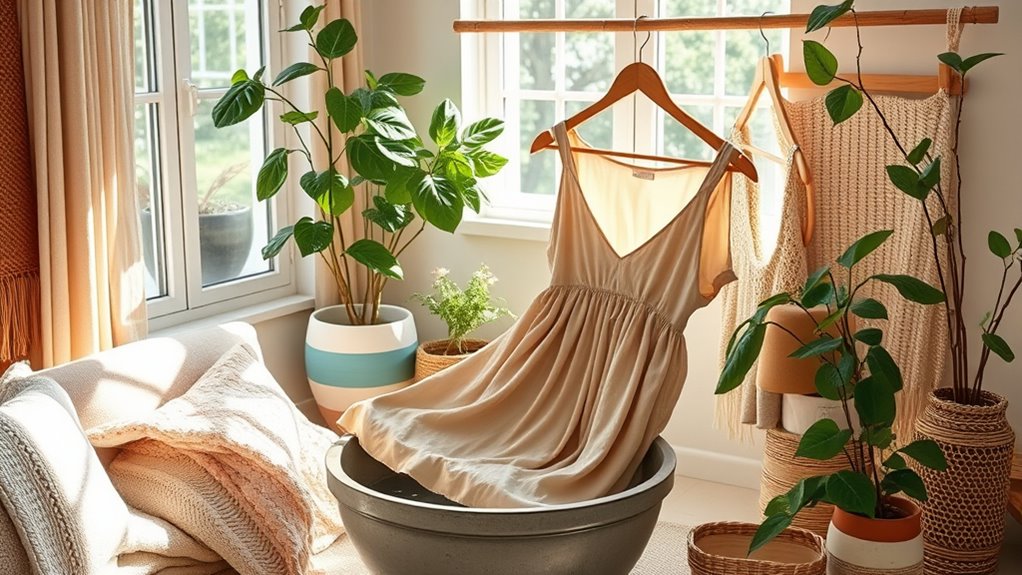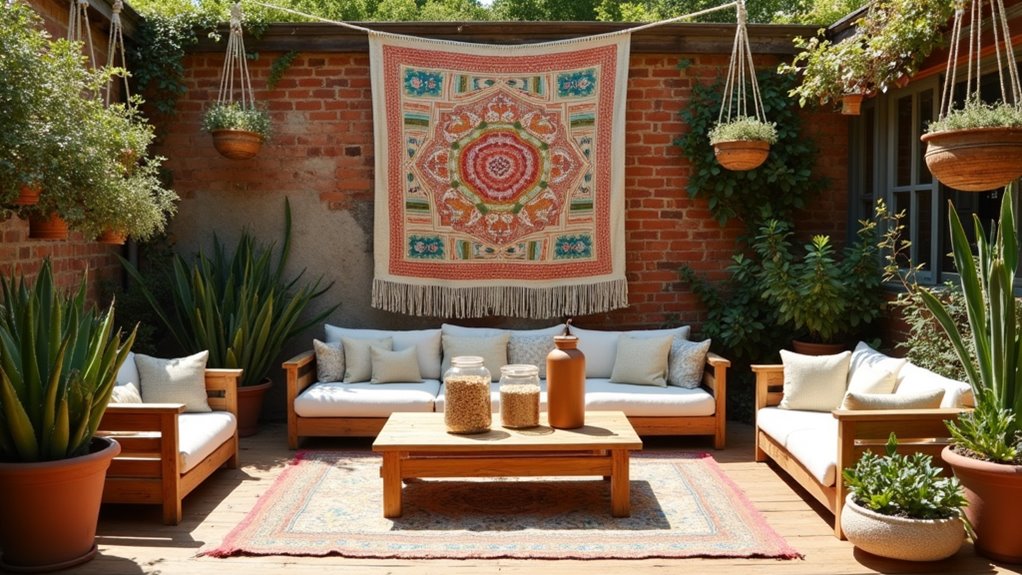To embrace a sustainable boho lifestyle, prioritize shopping from ethical brands that use natural and recycled fabrics, like organic cotton, hemp, or Tencel, and upcycle vintage finds for unique style. Reduce plastic waste with reusable bottles and zero-waste practices, while supporting eco-friendly travel options like trains and biking. Incorporate mindful routines such as conserving water and choosing sustainable products. Keep your wardrobe lasting longer by caring for eco-friendly clothes—discover how these habits can help you live freely and kindly to the planet.
Key Takeaways
- Incorporate eco-friendly fabrics and sustainable fashion choices, like organic cotton and recycled textiles, into your boho wardrobe.
- Practice zero-waste habits by using reusable containers, bags, and water bottles to reduce plastic consumption.
- Embrace vintage shopping and upcycling to create unique, eco-conscious boho looks that support sustainable fashion.
- Opt for eco-friendly transportation methods such as cycling, walking, or train travel to lower your carbon footprint.
- Cultivate mindful routines like conserving water, using sustainable products, and connecting with nature to promote a free-spirited, eco-conscious lifestyle.
Embracing Conscious Shopping and Ethical Brands

By choosing to shop consciously, you can support ethical brands that prioritize fair wages, safe working conditions, and environmentally responsible manufacturing. Ethical brands like Pact and People Tree focus on transparency, ensuring their supply chains meet high standards. When you practice conscious shopping, you select products made from sustainable fabrics such as organic cotton, Tencel, or recycled polyester, which minimize environmental harm. Doing your research helps you align your purchases with your values, supporting brands that prioritize eco-friendly production. By investing in quality, durable pieces instead of fast fashion, you reduce waste and promote sustainable consumption. Additionally, being mindful of packaging—favoring minimal, recyclable, or biodegradable materials—further supports your commitment to a circular economy. Your choices can make a meaningful difference in fostering ethical practices. Incorporating sustainable fabrics into your wardrobe not only benefits the environment but also supports the health of workers involved in production. Recognizing the importance of sound design principles can also inspire creative ways to promote your sustainable lifestyle through multimedia storytelling. Moreover, understanding contrast ratio and how it affects visual storytelling can help you create compelling content that highlights your eco-friendly journey. Being aware of carbon footprint can motivate you to choose brands that actively reduce their environmental impact.
Incorporating Natural and Recycled Fabrics Into Your Wardrobe

Switching to natural and recycled fabrics is a simple way to make your wardrobe more eco-friendly. Look for organic textiles like cotton, hemp, or linen, and consider recycled options such as polyester made from plastic waste. Taking care of these fabrics properly helps them last longer and keeps your sustainable style going strong. Incorporating vintage decor can also enhance the timeless appeal of eco-friendly fashion choices. Additionally, choosing Vetted electric bike conversion kits for eco-conscious transportation can further reduce your carbon footprint.
Choosing Organic Textiles
Choosing organic textiles allows you to make more sustainable fashion choices that benefit the environment. Organic textiles, like organic cotton, hemp, linen, and Tencel, are grown without harmful pesticides or synthetic chemicals, reducing environmental damage. Recycled fabrics, such as recycled polyester and nylon, help divert textile waste from landfills and lower resource consumption during production. By selecting natural and recycled fibers, you support sustainable farming practices and promote a circular fashion economy. These fabrics often require less water and energy, making them an eco-friendly option for your wardrobe. Incorporating organic textiles not only reduces your ecological footprint but also enhances the longevity of your clothing, meaning fewer replacements and less waste—perfect for a free-spirited, boho lifestyle. Additionally, choosing eco-friendly fabrics supports innovative materials and manufacturing processes that prioritize environmental conservation.
Recycled Fabric Options
Incorporating recycled fabric options into your wardrobe complements your commitment to sustainability by reducing waste and conserving resources. Recycled fabrics like polyester and nylon are made from post-consumer plastic waste, helping decrease landfill buildup and reliance on virgin synthetic fibers. Natural fibers such as organic cotton, hemp, and Tencel can be blended with recycled materials to create durable, eco-friendly boho clothing. Using recycled fabrics in your wardrobe supports circular fashion practices, ensuring minimal waste and pollution through closed-loop production systems. This approach not only lowers water and energy consumption during manufacturing but also promotes environmentally conscious choices. UV protection is another benefit of many natural fibers, which can help shield your skin from harmful sun exposure. By choosing recycled fabrics, you actively participate in sustainable fashion, making your wardrobe a symbol of your free-spirited, eco-friendly lifestyle. Additionally, selecting fabrics with transparent supply chains ensures that your clothing aligns with ethical and sustainable standards. Incorporating eco-conscious textiles from sustainable sources further enhances your commitment to environmental responsibility. Embracing ethical production practices also ensures that your clothing supports fair labor and sustainable development. Incorporating education on sustainable materials can help you make more informed choices and deepen your understanding of eco-friendly fashion options.
Sustainable Fabric Care
To keep your natural and recycled fabrics looking their best and extend their lifespan, adopting sustainable care practices is essential. In boho style, your wardrobe should reflect eco-friendly habits, starting with gentle cleaning. Use eco-friendly detergents made from plant-based ingredients to reduce chemical runoff and protect fibers. Washing in cold water conserves energy and prevents fiber degradation, especially for delicate fabrics like linen and hemp. Whenever possible, air-dry your garments to cut energy use and avoid unnecessary wear. Proper storage in breathable containers prevents mold and pest damage, maintaining fabric quality and sustainability. Always follow care instructions specific to each fabric type—avoiding bleach on natural fibers and opting for gentle cycles on recycled or delicate textiles—ensuring your boho wardrobe stays eco-conscious and beautiful for years. Additionally, choosing electric bikes for transportation can further reduce your carbon footprint and support a sustainable lifestyle.
Practicing Upcycling and Thrift Shopping for Unique Finds

By exploring thrift stores and vintage markets, you can discover one-of-a-kind pieces that elevate your boho style while reducing waste. Upcycling your finds allows you to add personal touches and create truly unique fashion statements. Plus, these practices support sustainability and spark your creativity in the process. To keep your accessories and clothing in great condition, learning about proper essential oils for maintenance and storage can help extend their lifespan and ensure they remain eco-friendly options. Incorporating raw food diet principles into your lifestyle can further promote sustainable habits and a mindful approach to living. Embracing eco-friendly materials, such as recycled or sustainably sourced fabrics, enhances your commitment to environmental consciousness in your fashion choices. Additionally, choosing best security systems of 2024 can help safeguard your eco-friendly home while you focus on sustainable living.
Vintage Treasure Hunting
Have you ever discovered a hidden gem while thrift shopping that instantly elevates your boho style? Vintage treasures are perfect for creating a unique, eco-friendly wardrobe. Shopping at thrift stores reduces textile waste and supports sustainable fashion practices. When you upcycle vintage finds by adding embroidery, fringe, or beading, you personalize your look while giving garments a second life. According to the EPA, recycling or thrifting one pound of clothing can save about 0.7 pounds of carbon dioxide emissions compared to buying new. Vintage pieces often feature high-quality craftsmanship and timeless designs, encouraging long-term wear and decreasing reliance on fast fashion. Practicing vintage treasure hunting helps support local economies and diverts garments from landfills, making your boho lifestyle both stylish and sustainable. Vintage machine mechanisms and historical craftsmanship can add an authentic touch to your collection. Incorporating sustainable fashion practices not only benefits the environment but also promotes ethical consumption. Engaging in positive thinking about your eco-friendly choices can reinforce your commitment and inspire others to adopt similar habits. Skincare patches can also be a useful addition to your eco-friendly routine by targeting blemishes with minimal waste.
Creative Personalization Tips
Practicing upcycling and thrift shopping opens up endless possibilities for creating unique, eco-friendly boho pieces. You can transform recycled materials into one-of-a-kind accessories or clothing, showcasing your creativity while reducing waste. Reimagining thrifted finds with DIY embellishments like embroidery, fringe, or beading personalizes your wardrobe and minimizes environmental impact. Plus, incorporating handmade or upcycled jewelry from natural or recycled materials elevates your eco-friendly boho style. To get started, consider these ideas:
- Add colorful embroidery to vintage denim jackets
- Attach fringe to skirts or bags for boho flair
- Use beading or shells to decorate thrifted jewelry
- Paint or dye recycled textiles for a fresh look
- Create statement pieces from upcycled fabric scraps
- Explore upcycling techniques to turn old items into new treasures
- Incorporate sustainable materials into your accessories and garments to further support eco-friendly fashion.
- Utilizing merchant services can also help small businesses accept various payment options, making your eco-conscious craft sales more accessible to customers.
Incorporating sustainable materials and practices not only enhances your style but also supports sustainable fashion efforts. These tips help you craft distinctive pieces while supporting sustainable fashion efforts.
Reducing Plastic Use With Reusables and Zero-Waste Tips

Switching to reusable items is one of the most effective ways to cut down on plastic waste. Reusables like water bottles, shopping bags, and containers help you eliminate single-use plastics. For example, swapping plastic bottles for reusable water bottles can save up to 167 bottles per person annually. Using reusable shopping bags instead of plastic bags reduces waste by around 1,000 bags per year per household. Zero-waste practices, such as bringing containers for leftovers or shopping in bulk, can eliminate thousands of plastic pieces each year. Washing and reusing glass jars extends their life and cuts down on new plastic packaging. Eco-friendly alternatives like beeswax wraps and stainless steel straws further reduce disposable plastic items, helping you embrace a more sustainable, free-spirited lifestyle.
Supporting Sustainable Travel and Eco-Friendly Transportation

Choosing eco-friendly transportation options allows you to extend your commitment to sustainability beyond reducing plastic waste. By making mindful choices, you support sustainable travel and minimize your carbon footprint. Opt for train travel over short flights, as it can cut your emissions by up to 90%. Walk or cycle for local trips to eliminate emissions and boost your well-being. Carpool or use ride-sharing services to lower individual emissions, fostering community. Support electric or hybrid vehicles, especially when powered by renewable energy sources. Additionally, choose eco-friendly accommodations and participate in offset programs to further reduce your environmental impact. Embracing these habits helps you stay true to your free-spirited, boho lifestyle while actively promoting sustainability. Every small step contributes to a healthier planet and more conscious travel experiences.
Cultivating Mindful Daily Routines and Eco-Conscious Habits

Incorporating mindful daily routines and eco-conscious habits into your life can markedly reduce your environmental impact and enhance your sense of well-being. Small actions, like taking quick showers and reusing water, save thousands of gallons annually. Choosing sustainable products made with ethical production methods, such as organic cotton clothing and eco-friendly household goods, lowers your footprint over time. Carrying reusable bottles and bags prevents hundreds of single-use plastics from polluting landfills. Engaging in morning meditation or nature walks nurtures your spirit and reduces stress. To visualize your efforts:
| Habit | Impact |
|---|---|
| Reusing water | Saves water and energy consumption |
| Using reusable items | Cuts down on plastic waste |
| Choosing sustainable products | Supports ethical production methods |
| Mindful practices | Enhances mental well-being |
These routines cultivate a balanced, free-spirited lifestyle aligned with sustainable habits.
Caring for Your Eco-Friendly Clothing to Extend Its Lifespan

Taking proper care of your eco-friendly boho clothing can considerably extend its lifespan and reduce textile waste. To do this, follow sustainable practices that preserve your garments’ fibers and quality. Wash your eco-friendly clothing in cold water with gentle, eco-conscious detergents to prevent fiber damage. Air-dry instead of using a dryer to avoid fabric deterioration and save energy. Store your garments in breathable garment bags or folded gently in drawers to minimize environmental wear and tear. Regularly repair small damages like loose seams or missing beads to keep your clothes wearable longer. By adopting these simple habits, you not only prolong the life of your wardrobe but also contribute to a more sustainable lifestyle. Small, mindful actions make a big difference.
Inspiring Others and Building a Community of Green Living

Have you ever wondered how your eco-friendly choices can influence others? When you share your tips and success stories, you create a ripple effect in your community, inspiring more people to adopt sustainable habits. Organizing local swap events and workshops encourages resource sharing, upcycling, and collective learning about boho eco-conscious living. Supporting eco-conscious brands and artisans amplifies the message of green fashion and mindful consumption. Using social media to showcase your lifestyle choices can reach a wider audience, sparking online communities dedicated to sustainability. Participating in community projects like tree plantings and clean-up drives strengthens collective action and reinforces your values. By inspiring others, you help build a vibrant community committed to free-spirited, eco-conscious living for a healthier planet.
Frequently Asked Questions
What Are 3 Examples of Living Sustainably or Being Sustainable?
You’re wondering about ways to live sustainably. You can start by using reusable bottles and containers to cut plastic waste markedly. Next, opt for energy-efficient appliances and consider installing solar panels to lower your carbon footprint. Finally, support local, seasonal, and organic foods to reduce emissions from transportation and industrial farming. These habits help you live more eco-friendly and align with a free-spirited, sustainable lifestyle.
What Are Five Eco-Friendly Habits?
Imagine saving over 4,000 plastic bottles a year just by switching to a reusable water bottle—that’s an eco-friendly habit you can adopt. Five habits include using reusable bottles and cups, choosing eco-friendly fabrics, practicing recycling and upcycling, conserving water with shorter showers, and supporting sustainable brands. These simple steps help reduce waste, save resources, and promote a greener lifestyle, aligning with your free-spirited, eco-conscious values.
What Is Sustainable Living and Eco-Friendly Lifestyle?
Sustainable living means you actively reduce your environmental impact by conserving resources, minimizing waste, and choosing eco-friendly products. An eco-friendly lifestyle involves making mindful decisions like recycling, supporting ethical brands, and conserving energy and water. By adopting these habits, you lower your carbon footprint and help protect the planet. It’s all about living freely while being conscious of how your choices affect the environment around you.
What Are 10 Ways to Be More Sustainable?
Imagine your daily choices as a brushstroke on the canvas of Earth’s future. You can reduce waste by using reusable bottles and bags, choose fabrics like organic cotton, and buy only what you need. Fix leaks to save water, support eco-friendly brands, and recycle or upcycle. These small acts add up, transforming your lifestyle into a vibrant, sustainable masterpiece that honors and preserves our planet’s natural beauty.
Conclusion
Embracing these eco-friendly habits transforms your life into a vibrant tapestry woven with purpose and passion. Every conscious choice becomes a brushstroke of kindness to the planet, turning your free-spirited journey into a beautiful dance of sustainability. Keep shining your light, inspiring others to join the eco-conscious chorus. Together, you’re crafting a world where nature and spirit flourish hand in hand—your sustainable lifestyle a radiant beacon guiding the way to a greener, freer tomorrow.









